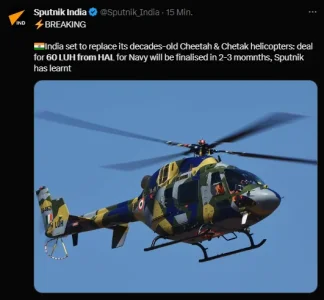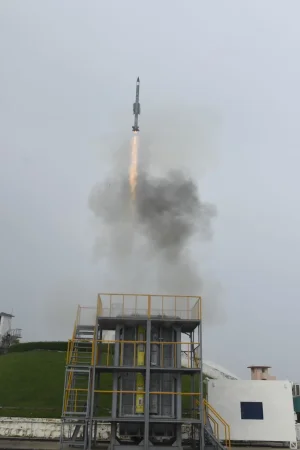Ok man, India bestestest!! WOO FUCKING HOO!! There, ye 'appy now??Ok let's go to US and ask for Mk-41, then what? Will we be able to integrate our missiles in the VLS? Won't they charge for it ( as if they will allow the integration). Navy is in a deep state of modernization, so lot of mismatching is happening - some cases ships are there but technology is being developed and in other case technology is there but ships are to be produced. Once, every thing aligns then only you see what you want to see.
You are using an out of date browser. It may not display this or other websites correctly.
You should upgrade or use an alternative browser.
You should upgrade or use an alternative browser.
Indian Navy Developments & Discussions (46 Viewers)
- Thread starter 125mm_Smoothbore
- Start date
More options
Who Replied?- Joined
- Jul 8, 2024
- Messages
- 1,989
- Likes
- 13,893
1) MFSTAR + Barak 8 (LRSAM) combo is the AN SPY-1D/SPY-6 (AEGIS) + SM2/SM6 combo for India.I need to express some serious concerns about the current state of the Navy’s vessel strategy, particularly when it comes to classes like the Nilgiri and Vishakapatnam. While we often hear high praise for the Navy, it seems to me that their strategy is lacking in several crucial areas. The SSBN program and ASWSWC are commendable, but other aspects appear to be misaligned with effective naval strategy.
Take the Nilgiri Class, for instance. Are they being built solely to meet a numerical target by 2030, without considering their actual role and effectiveness in modern naval warfare? This approach seems to lack strategic foresight of what each kind of class constitutes in broader strategy.
When evaluating the role of these ships in Anti-Surface Warfare (ASuW) and Land Attack scenarios, it becomes clear that their design may not be the most efficient. Globally, navies are moving away from building small to medium-sized frigates (<7000 tons) for these roles. The cost-effectiveness of using fighter jets, surface-launched missiles, or aircraft carriers for strikes is much higher. If the intent is for these ships to engage offensively beyond our territorial waters, the number of just eight missiles is insufficient. On the defensive side, using fighter jets armed with BrahMos missiles would be more effective against incoming ships from the PLAN.
For Anti-Submarine Warfare (ASW), the Nilgiri Class seems to be an overkill in several aspects. The inclusion of a 4-panel AESA radar and L-band early warning radar appears excessive. A 2-panel rotating radar would suffice for ASW operations. Similarly, the choice of Barak-8 missiles seems excessive; more cost-effective options like ESSM or VL-SRSAM would be adequate. Additionally, the lack of ASROC-type missiles in favor of torpedoes alone seems to be a missed opportunity. The single helicopter hangar, rather than two, severely limits the availability of ASW helicopters for missions. The absence of electric motors, which are present in other advanced frigates like the FREMM or Type 26, is another significant shortcoming.
In terms of Anti-Air Warfare (AAW), while the radars are indeed top-notch, the deployment of only 32 Barak-8 missiles raises questions. This setup lacks a high-low mix, which is critical for effective AAW. The combination of two expensive radars with a limited number of missiles suggests a mismatch in capability and expenditure.
The design appears to be an attempt at a general-purpose frigate, but this approach does not justify the inclusion of an early warning radar, especially when the ship lacks a long-range surface-to-air missile (LRSAM) system. At a cost of approximately 1 billion dollars, the vessel seems to be a half-assed jack-of-all-trades but master of none. It falls short of effectively fulfilling any of the roles it is supposed to cover.
You aren't gonna send this 1 Billion ship to fight Asymmetric Warfare, Secure Shipping Lines, Anti-Piracy right?
Overall, the Nilgiri Class represents a costly and inefficient solution that does not seem to address the broader needs of our naval strategy effectively. It appears to be a poorly executed attempt to cover multiple roles without excelling in any.
I really like Navy to answer themselves? What do they intend to achieve with this half-assed ships?
Personally I think we need
1. ASWSWC(For Inshore ASW Duties)
2. 6000 Ton ASW Frigate for both Carrier Escort Roles and Filtering out waters in far away from Coast
3. A General Purpose Tier-2 Frigate for all Generic Duties such as Anti-Piracy, Maritime Security.. Second tier duties.
4. 12,000 Ton Multi Role Destroyer.
Navy got 2 things right, the ASWSWC and NGD while the Nilgiri and Vishakapatnam excel at none- neither AAW nor ASW.
These ships provide terminal ballistic defence in addition to area AD for the fleet.
2) 3 Kolkata P15A + 4 Vishakapatnam P15B + 7 Nilgiri P17A + 7 'x' P17B = 21 AESA MFSTAR ships capable of locking down eastern and western seaboards.
3) The Tier 2 Frigate role for Indian Navy is the Talwar Class.
3 Batch I + 3 Batch II + 4 Batch III = 10 line ships
4) NGOPV and NGMV are the planned Tier 3 ships for humanitarian, disaster relief, piracy, gunboat diplomacy, exercises, covert operations, etc
5) I believe VL-SRSAM (24-32) will make its way to most Navy ships
- Joined
- Jul 1, 2024
- Messages
- 358
- Likes
- 2,658
Ok man, India bestestest!! WOO FUCKING HOO!! There, ye 'appy now??
View: https://x.com/DefSysCI/status/1831266086983282701?t=HbKexhA_1BueVCf24hk0Ew&s=19
- Joined
- Jul 2, 2024
- Messages
- 33
- Likes
- 254
It doesn't make sense to compare cost in USD when >70% of the content is bought in INR. And amount cleared by DAC isn't "maximum", it's just "current estimate", it can increase by the time it reaches contract dates.Project 17A was approved for 45000 cr ₹ in 2009, 9.8 billion $ in 2009's exchange rate.
Project 17B is now costing 70000 cr ₹ in 2024, i.e 8.3 billion $ in 2024's exchange rate.
they got cheaper in $ value. and these are project costs, not just the ships alone.
This thread assumes an YoY inflation of 4% for 10 years, 1.5× increase in price
45×1.5 is 67.5, close to 70k
View: https://x.com/DefSysCI/status/1831266104297283756?t=Ew9BWCp8-ig23rgzaPwE8Q&s=19
BrahMos won't fit in Mk41, IN is not ready to pay exorbitant integration costs for Mk41. A new cell can be developed for less than what it would cost to integrate our weapons in Mk41.Baat wo nehi hai. People are just concerned about the sparse armamemt profile of our ships. Sure, at a first glance, these have the same number of VLS cells as any other frigates but their each VLS cell is equivalent to 4 of the Barak 8 cells, let's not even mention the reduced flexibility it causes.
I just wonder why no one ever thought about getting the Mk41 VLS system from Uncle Sam?? It's not as if we aren't using their engines.
Mk41 is a little over 600mm, and MR-SAM is 225mm in diameter (less than ESSM) but its control surfaces even in folded configuration exceed 300mm, not feasible.
First, it would be MR-SAM, then VL-SRSAM, LR-LACM, then PG-LRSAM. The Navy isn't willing to pay for a foreign system when it is cheaper to develop and manufacture a new type of VLS.
LR-LACM is being integrated into the UVLM interface, and a new cell will be fitted in the same module, similar to how Mk41 works.
Work on UVLM hasn't started afaik. Right now IN has the option to modify UVLM for hot launching SAMs. UVLM provides IN with a square interface with a side of ~850-900mm, different cell designs can be designed to fit into this interface, like how BrahMos' 800mm circular cell is designed or how LR-LACM' circular cell is being designed.So, no UVLS to be expected within this decade then?? And are they gonna have CODLAG or the same CODAG??
P17A features CODOG, Gas for high speed and Diesel for quiet and low speeds. Not operated at the same time.
Of course they won't, but we could always use 2 different types of VLS systems like the Russians are doing - one large enough to houseBrahMos won't fit in Mk41, IN is not ready to pay exorbitant integration costs for Mk41.
 and later the irregular shaped hypersonic missiles, and a smaller one for others.
and later the irregular shaped hypersonic missiles, and a smaller one for others.Of course now it will cost us an arm and a leg now that the missiles have already been developed!! What I meant was, why didn't they think of this 10 to 15 years ago!! Or if not the Mk41, then at the very least, why it never occurred to anyone to try and make one ourselves??!! It's not as if they didn't have access to the internet, now is it??!!IN is not ready to pay exorbitant integration costs for Mk41. A new cell can be developed for less than what it would cost to integrate our weapons in Mk41.
First of all, its cross section is 25" square, so that's a lot more than 600mm, and therefore, it shouldn't be a problem even if the folded fins exceed 300mm. Besides, you could always pack the missiles in a way so that the fins would sit diagonally inside their individual cells.Mk41 is a little over 600mm, and MR-SAM is 225mm in diameter (less than ESSM) but its control surfaces even in folded configuration exceed 300mm, not feasible.
And lastly, are you certain your calculations are correct?? From a rough pixel count, I don't see them exceeding 280mm.
P17A features CODOG, Gas for high speed and Diesel for quiet and low speeds. Not operated at the same time.
Sorry, I keep mixing up the two, my bad.
- Joined
- Jul 2, 2024
- Messages
- 33
- Likes
- 254
We thought of this 15 years ago and UVLM is a result of that thought, it isn't just for BrahMos, or just BrahMos + LR-LACM, it will continue to get new missiles integrated. Quad packing of missiles like VL-SRSAM or MR-SAM can be done, IN has to put forward such a request.Of course they won't, but we could always use 2 different types of VLS systems like the Russians are doing - one large enough to houseand later the irregular shaped hypersonic missiles, and a smaller one for others.
Of course now it will cost us an arm and a leg now that the missiles have already been developed!! What I meant was, why didn't they think of this 10 to 15 years ago!! Or if not the Mk41, then at the very least, why it never occurred to anyone to try and make one ourselves??!! It's not as if they didn't have access to the internet, now is it??!!
24 inches of usable space, that's around 609mm. The control surfaces and cell walls need at least 5mm between them, Mk41 can not provide that. Similarly, UVLM has a usable space of around 850mm, even though the cell cap is around 1000mm.First of all, its cross section is 25" square, so that's a lot more than 600mm, and therefore, it shouldn't be a problem even if the folded fins exceed 300mm. Besides, you could always pack the missiles in a way so that the fins would sit diagonally inside their individual cells.
I am certain. VL-SRSAM is around 265*275mm when folded, and MR-SAM is close to 300mm, I am not talking about diagonals (close to 350mm for folded VL-SRSAM).And lastly, are you certain your calculations are correct?? From a rough pixel count, I don't see them exceeding 280mm.
- Joined
- Jul 1, 2024
- Messages
- 358
- Likes
- 2,658
- Joined
- Jul 8, 2024
- Messages
- 1,989
- Likes
- 13,893
- Joined
- Jul 1, 2024
- Messages
- 358
- Likes
- 2,658
- Joined
- Jun 30, 2024
- Messages
- 2,030
- Likes
- 7,041
- Joined
- Jul 1, 2024
- Messages
- 358
- Likes
- 2,658
Non-sense.
Cheetah is not operated by Navy and LUH has not been optimised for naval operation as of now.
Either it is for Army or it could be UHM.
- Joined
- Jul 6, 2024
- Messages
- 502
- Likes
- 3,465
- Joined
- Jul 6, 2024
- Messages
- 502
- Likes
- 3,465
- Joined
- Jun 30, 2024
- Messages
- 1,815
- Likes
- 23,181
- Joined
- Jun 30, 2024
- Messages
- 2,030
- Likes
- 7,041
- Joined
- Jul 1, 2024
- Messages
- 1,084
- Likes
- 3,652
It's just AoNHow many nos?
Basically for development and realisation
Numbers will be finalized later
When's moon and mars tests taking place? It already had 5 full configuration tests before, including one from a Naval ship. This is the 6th test, and yet no news of operational integration.
Not before the ships are sent for their periodic refits but the day is close now. Anyway, this launcher assembly is way too bulky for a missile of this size.When's moon and mars tests taking place? It already had 5 full configuration tests before, including one from a Naval ship. This is the 6th test, and yet no news of operational integration.
- Joined
- Jun 30, 2024
- Messages
- 2,030
- Likes
- 7,041
Users who are viewing this thread
Total: 40 (members: 14, guests: 26)

Latest Replies
-
Indian Navy Developments & Discussions
- randombully
-
AMCA - Advanced Medium Combat Aircraft
- obiwankenobi
-
Indian Special Forces
- Baseplate
-
Indian Economy
- liberalredditor
-
DRDO & PSUs
- shade2
-
Russian Ukrainian War
- shade2
-
China Watch
- shade2



